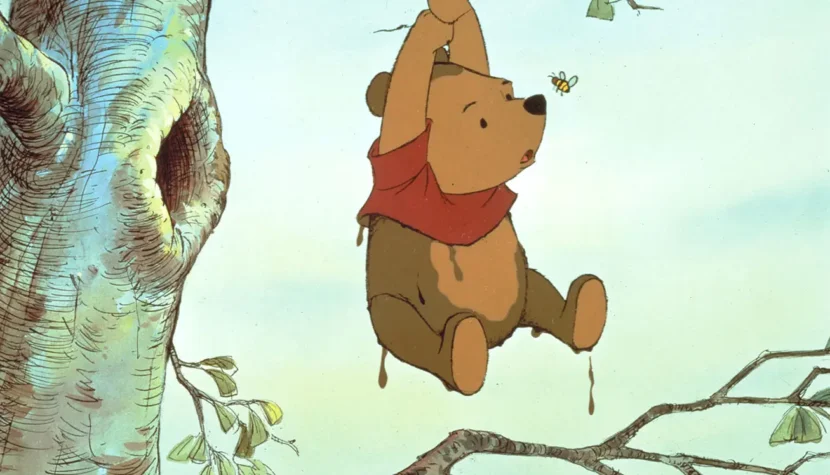THE MANY ADVENTURES OF WINNIE THE POOH. Message-driven film for the youngest

In The Many Adventures of Winnie the Pooh, the narrative simplicity is not a flaw—it’s an enormous asset and a defining feature. It’s the essence of this work’s charm. This simplicity is a key component that shapes the unique style, atmosphere, and character of the film. Consider just a few of the early scenes: Pooh’s rumbling, hungry tummy wakes him up in the morning. Every honey jar he owns is depressingly empty. Fortunately, nearby, high up in a tree, bees have built a juicy hive. To reach it, Pooh needs a balloon. The balloon will lift him to the right height. But first, Pooh covers himself in mud to disguise himself as a “little black rain cloud.” The bees won’t suspect a thing, and he’ll satisfy his hunger. It’s a delightful plan—something only someone with Pooh’s innocent imagination and “very little brain” could devise. And every time, I buy into it. It just has to work.
Many other scenes (like Pooh and Piglet tracking their own footprints) and props (like a cork-loaded pop gun with a string attached to the barrel) follow the same whimsical logic. This is a carefree world devoid of malice—because that’s how a child typically views it. The Many Adventures of Winnie the Pooh captures this bliss, tranquility, and innocence perfectly. It’s achieved through the innate kindness of the characters, soft color palettes, a hand-holding narrator, and the happy endings to every adventure.

On a formal level, despite the charmingly naive narrative style, The Many Adventures of Winnie the Pooh is remarkably sophisticated. The entire story unfolds on the pages of a book. The placement of illustrations on particular pages matters—characters often traverse these pages. In one scenario, after a hearty second breakfast, Pooh gets stuck in Rabbit’s tunnel. His head and legs are separated by several pages, emphasizing the scale of the problem. In another instance, Tigger climbs too high in a tree. His rescue comes not from his friends’ motivational shouts but from the intervention of the narrator-reader, who tilts the book, allowing Tigger to safely step onto a nearby paragraph.
From this perspective, The Many Adventures of Winnie the Pooh emerges as a total adaptation. It draws from A.A. Milne’s work not only in terms of sentences, art style, rhythm, and plot but also, most surprisingly, the physical form of the book—the medium of its origin. This makes The Many Adventures of Winnie the Pooh a creative and uniquely exceptional piece of cinema. It’s a prime example of the synergy between books and films.
The Many Adventures of Winnie the Pooh is a message-driven film, directed at the youngest viewers. It fosters specific attitudes and behavioral models. Friendliness, empathy, understanding, and the ability to show compassion are fundamental character traits everyone should embrace. When Owl’s house is destroyed, his friends immediately come to his aid. When Piglet is swept away by a flood, a rescue mission is launched. The arrogant Rabbit finds joy in bouncing—a favorite activity of Tigger’s—despite initially plotting to punish him by abandoning him in the woods. These are simple and clear examples, delivered with lightness and a convincing charm.

Toward the end, the creators strike a slightly more nostalgic chord. Christopher Robin takes Pooh for a walk. The boy asks Pooh never to forget him, explaining that the days of doing nothing are coming to an end. The time is near when he’ll have to go to school, trading toys for notebooks and textbooks. The carefree days of wandering through the Hundred Acre Wood will be over.
At this moment, The Many Adventures of Winnie the Pooh reaches an emotional peak, offering a wave of feelings and reflections later echoed by Pixar in the conclusion of Toy Story 3. It’s a story about the inevitability of parting with childhood friends. Pooh will remain only in Christopher Robin’s memory, a comforting relic of his youth. In adult life, there is no room for a simple plush bear. It’s beautiful, bittersweet, and true.

